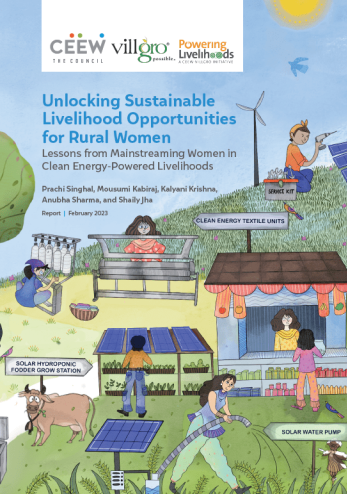Report
Creating Jobs and Income: How Solar Mini-Grids Are Making a Difference in Rural India
Madhura Joshi, Marie McNamara, Akanksha Tyagi, Sameer Kwatra, Neeraj Kuldeep
March 2021 | Sustainable Livelihoods
Suggested citation: Joshi, Madhura, Marie McNamara, Akanksha Tyagi, Sameer Kwatra, Neeraj Kuldeep. 2021. Creating Jobs and Income: How Solar Mini-Grids Are Making a Difference in Rural India. New Delhi: Council on Energy, Environment, and Water; Natural Resources Defense Council; and Skill Council for Green Jobs.
Overview
This case study focuses on Mlinda’s “energy services and development-based” business model to scale DRE in the Indian state of Jharkhand. It outlines how mini-grids can create employment and improve livelihoods and also collates the experiences of other DRE providers.
This study is part of a series which focuses on understanding the ecosystem and employment potential of emerging distributed renewable energy (DRE) technologies.
Key Findings
- The construction of commissioning of a Mlinda mini-grid takes about 5 months.
Mini-Grid Project Phases and Jobs (for a 25 kW Capacity Mini-Grid)
- 986 cumulative jobs have been created by Mlinda’s deployment of 45 community mini-grids (typical capacity between 23-30 kWp) in Jharkhand. These jobs include
- 180 direct full-time jobs,
- 131 full-time equivalent jobs from contractual work, and
- 675 productive-use jobs through additional entrepreneurial activities like solar pumps, rice hullers, wheat mills etc.
Employment Estimates from Mlinda’s Mini-Grid Deployment
Source: NRDC-CEEW-SCGJ estimates based on Mlinda data, 201959
Note: All values are shown as full-time equivalent jobs; the jobs figures in this table represent the number of jobs across Mlinda’s entire mini-grid portfolio (45 mini-grids at the time of this report)
- An estimated 619,000 to 1,134,000 direct and productive use jobs could be created by adding 1,000 MW of new mini-grid capacity if Mlinda’s business model is replicated
619,000 to 1,134,000 direct and productive use jobs could be created by adding 1,000 MW of new mini-grid capacity if Mlinda’s energy services and development-based business model is replicated.






